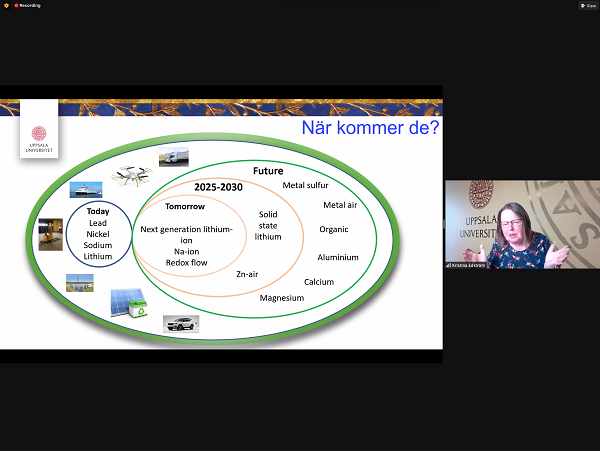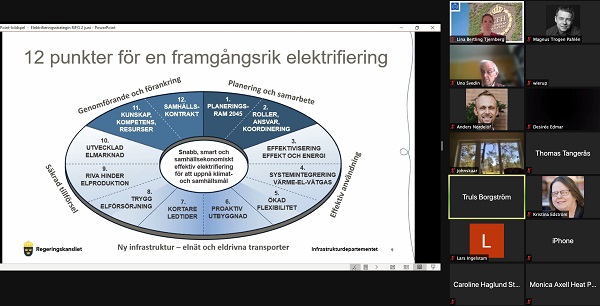The way forward to widespread electrification of society and achieving UN climate goals
The electrification of Sweden’s transport sector is well underway with Swedish industry set to play a key role in the process. Rifo recently organized a seminar in which researchers and experts from the transport sector, the electrical grid, the electricity market, and the battery sector shared their knowledge with Swedish MPs. Discussions centered on how continued electrification of society has the potential to make a vital contribution to meeting UN climate goals.

Betty Malmberg, MP and Rifo chairman, opened the seminar - entitled “How widespread electrification can meet climate goals - and how to do this in the best way possible” - by highlighting the need for energy security in the future. This is a key issue on which it is important that researchers and experts share knowledge to support politicians’ decision making. Malmberg added that she hoped that the seminar would also provide input into the ongoing work on the government’s national electrification strategy.
Moderator Lina Bertling Tjernberg, Rifo deputy chairman and professor in electrical grids at KTH Royal Institute of Technology, said that the digital format of the seminar had made it possible for hundreds of people from throughout Sweden to participate in the event.
Sweden tops EU in electric light vehicle numbers
Anders Nordelöf, researcher and theme leader at the Swedish Electromobility Centre, Chalmers University of Technology, opened the seminar. He provided a snapshot of the current state of electrification of the transport sector and outlined challenges and opportunities.
Sweden currently has the highest proportion of electrically powered light vehicles in the EU. In Europe as a whole, this list is topped by Norway and Iceland. In 2020, the proportion of new vehicle registrations for electric vehicles in Sweden was nine per cent, while plug-in hybrids accounted for 22 per cent. Growth in electric trucks was not as pronounced. However, the use of electric buses has increased sharply. For example, 39 per cent of all Västtrafik, (a regional transport provider in Sweden), bus services are electrified.
Nordelöf stressed how electrification of aircraft and ships was previously considered impossible, but that now advances are being made in both these areas. There are examples of electric aircraft with a capacity of approximately 20-40 passengers that are set to enter service before 2030.
One trend in this area is the emergence of new mobility solutions, such as sharing services and new business models.
There is a clear need for a nationwide fast-charging network, Nordelöf said. It is estimated that one fast charger is needed per 80 to 130 rechargeable vehicles, which would mean approximately 55,000 fast chargers for electric passenger vehicles.
Nordelöf also provided insights into alternative solutions for battery charging such as electric roads and growing interest in hydrogen and fuel cells. Sweden is a pioneer in terms of electric roads with several pilot facilities.
In the future, new forms of plug-in hybrids may emerge, Nordelöf said, with a variety of combinations of fuel cells and second-generation biofuels.
Research drives efficiency
Kristina Edström, professor and research lead at the Ångström Advanced Battery Center (ÅABC) at Uppsala University also spoke. Edström leads the Battery 2030+ European research initiative, which aims to make Europe a world leader in the development and production of the batteries of the future.
She emphasized the need for more research to make battery technologies and hydrogen as efficient as possible and minimize energy losses. With today’s battery technologies, electric power components cause the majority of energy losses.
Lithium technology is set to dominate battery technology for a number of years to come. But in the long run, the availability of raw materials for batteries will be a key factor. This can open up potential for developing different battery technologies for different applications.
Edström argued that the future will offer a mix of several battery technologies and hydrogen solutions. New technologies are being developed against a landscape of different chemical solutions. But the area will continue to require concerted fundamental research to move forward, she said. This is an area where Sweden has an advantage, with access to the Max IV and forthcoming ESS research environments.

In light of raw material challenges, many ask whether Europe should not be more active in mining these materials as our consumption of critical materials is almost ten times as high as our extraction of them. This further highlights the need for more durable battery materials that are also recyclable.
In her concluding remarks, Edström spoke about the sector’s pressing need for skill sets, an area in which Sweden can contribute with key initiatives.
Opportunities to meet climate goals
Bertling Tjernberg then took the floor and highlighted how the electrification of the transport and industry sectors could contribute to the UN’s climate goals for sustainable development.
She began by providing details of the Swedish electricity grid and a quick run-through of current electricity production in Sweden. The country’s electricity mix is shifting towards renewable energy sources, primarily wind and solar. This creates several challenges, including a greater need for increased flexibility to counteract capacity shortages.

Bertling Tjernberg said that efforts are required in three areas to create an electricity system fit for a sustainable society.
The first is more intelligent and adaptable networks in which digital tools provide opportunities for improved control, monitoring, and security. This also opens up opportunities for new players and market solutions, for example when consumers become electricity producers with the help of local electricity production from wind or solar.
A second area highlighted by Bertling Tjernberg was the need for a flexible grid infrastructure with new power electronics that facilitate the integration of renewable energy sources, local production, and electric vehicles.
The third area relates to improved components and environmentally friendly solutions in the form of new technologies for transformers, cables and switching components.
Already today, there are examples of pilot projects where new technologies are used to increase capacity with the help of wind and solar power, for example on the island of Gotland.
She concluded by highlighting the need for a national energy strategy in which electrification is a key component. A clear strategy to make Sweden a net electricity exporter could pave the way for more investment from new players.
Bertling Tjernberg concluded by emphasizing the need for new knowledge of the fundamental technological shift that is underway and that will see the country’s higher education institutions being able to contribute in more ways.
Approximately 200 networks and switching stations and around 16 international transmissions.
Flexible electricity markets as a solution
The next speaker was Thomas Tangerås, head of the electricity market programme at the Institute for Business Research. Tangerås said that a reliable and resource-efficient electricity supply requires sufficient electricity production at all locations and at all times. Bottlenecks in the system currently make this impossible.
In addition, network imbalances will be more prevalent in the future, he said. Here, a rapid expansion of electricity networks is needed - which is also ongoing, although expansion takes time. One solution may be new and very local electricity pricing, even at district level in larger cities. Under such systems, electricity prices need to fluctuate almost in real time, Tangerås said.
Similar “flexi-markets” are already in the pilot phase in several places in Sweden, including Stockholm, Uppsala and Malmö. However, these face challenges, including integration with the Nord Pool marketplace. Tangerås said, however, that the biggest challenge to flexi-markets is political in the form of the introduction of large, local price variations around the country.
However, he said that new market models have the potential to create a better balance between electricity production and consumption in the future.
A 12-point plan for electrification
Truls Borgström, co-ordinator of Sweden’s national electrification strategy at the Ministry of Infrastructure, then provided an insight into work being done on Sweden’s national electrification strategy.
Borgström gave an overview of the Swedish government’s 12-point plan for the successful electrification of the country that was presented in March by Minister of Energy and Digital Development, Anders Ygeman. (You can read the 12 point-plan here on the Swedish government website, (in Swedish)).
Borgström went on to talk about considerably higher electricity demand in the future as industry follows in the footsteps of the electrification of the transport sector. And the challenges for widespread electrification differ across the country, he said.
Widespread electrification of society will require considerable efforts from a large number of stakeholders. A guiding strategy for this process will be vital. This will require a large degree of collaboration between network owners at different regional levels and between various parties in the sector.
Knowledge about what the transition will entail needs to increase, and there is also a need for more competence for the sector for the future, he said.
Panel debate flagged for new cooperation
The seminar wrapped up with a panel of MPs including Helena Gellerman (Liberal Party), Lars Hjälmered (Moderates), Lorentz Tovatt (Green Party), and Patrik Engström (Social Democrats).
Earlier in the day, the panelists had participated in a parliamentary debate on electric aviation. Now their perspective was broadened to include the whole of society.
The panel discussion raised a range of issues including greater focus on the roll-out of charging infrastructure to improved cost control of the energy system, to Sweden's ability to contribute to the production of materials critical for future battery production. The supply of skills in the sector was also raised as an important political issue.
Finally, the moderator asks all the panel speakers if they are willing to work for a renewed collaboration for an energy agreement (similar to the previous energy agreement entered into in 2016 between five Swedish parliamentary parties).
All panelists agreed that there was a need for greater collaboration.
Some participants said that the way to achieve this could be through greater focus on issues and an openness to include more areas in the energy sector.
A recording of the seminar will be published at the home pages for KTH energyplatform. An article from a previous seminar is found here (in Swedish): Här fyller politiker på med kunskap från energiforskare och industri | KTH
Text by: Magnus Trogen Pahlén